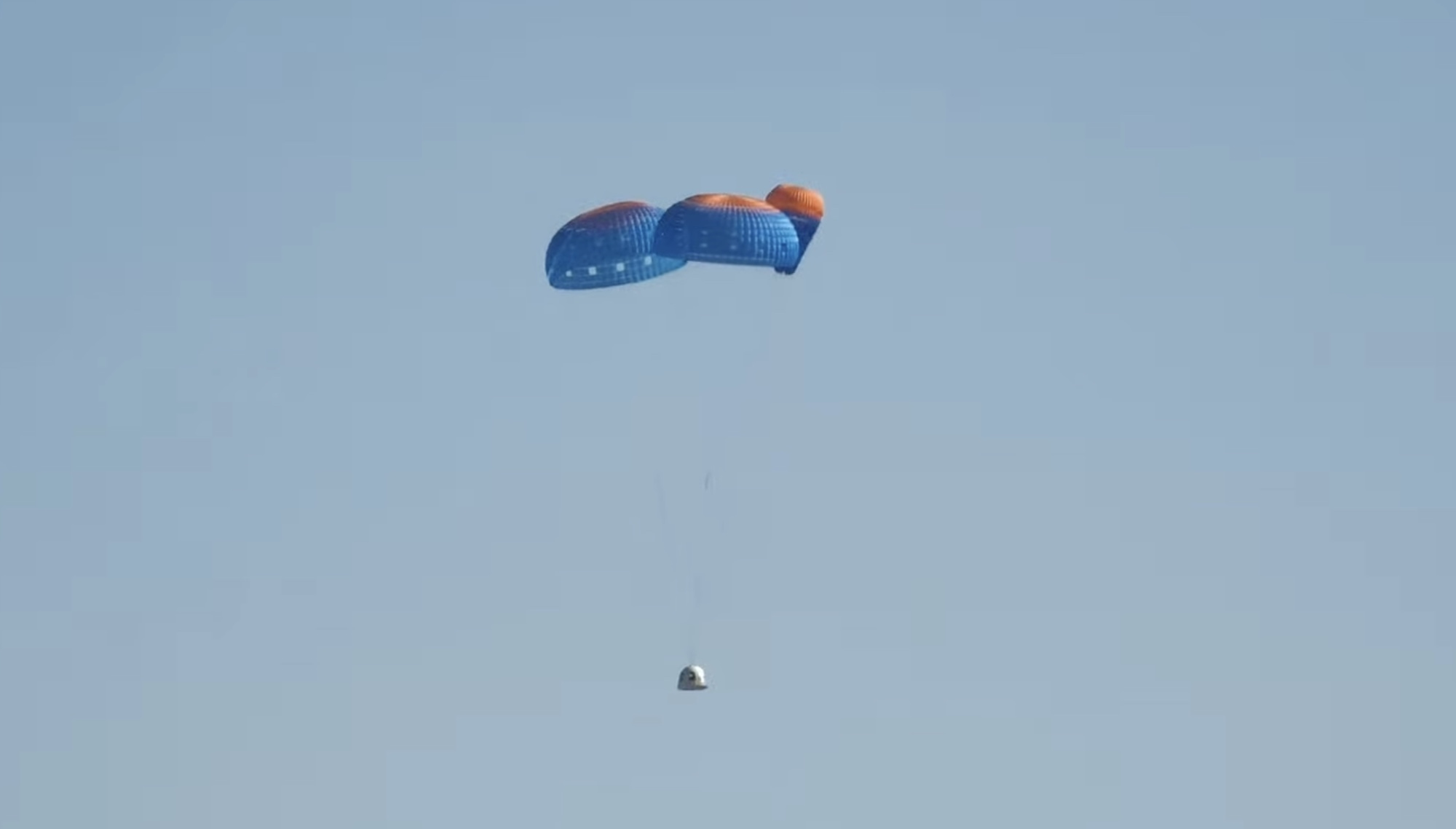“Probably the best chance of finding current life
in our solar system right now would be on Europa.”
– Richard Greenberg, Ph.D., Univ. of Arizona
Reprint September 22, 2016, prior to NASA’s upcoming Sept. 26, 2016,
LIVE global teleconference about “Surprising Evidence of Activity On Europa.”
September 26, 2016 — Live Stream Will Be Here.
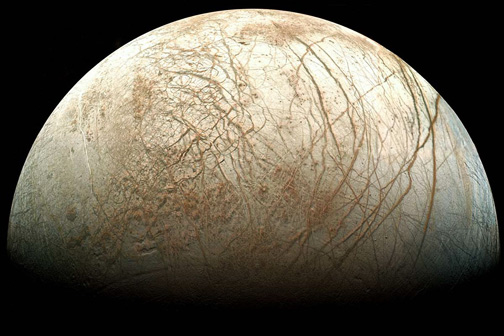
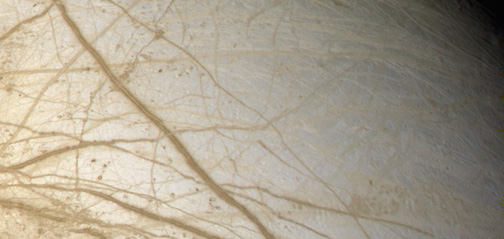
Reposted December 20, 2023 – Updated November 2, 2009, with podcast and Europa book information at end of report from Tucson, Arizona – There is a moon in our solar system that is about the size of Earth’s moon, but beneath its icy surface is a liquid water ocean 62 miles deep. That moon is Europa, one of 49 known moons that orbit Jupiter, of which Europa, Io, Ganymede and Callisto are the largest.
Earlier this year, NASA announced that its next proposed multi-billion-dollar robotic space project will be the Europa Jupiter System Misson. If funding proceeds, NASA’s Europa orbiter will launch in 2020 and will be joined by a European Space Agency craft that will focus on Ganymede while NASA looks for life on Europa. Ganymede, the largest moon in our solar system, larger than the planet Mercury, might also have an ocean!
Traveling from Earth to Jupiter will take the two spacecraft six years and another 2.5 years for NASA to get into orbit around Europa and for the European Space Agency to get into orbit around Ganymede by 2029.

One scientist here on Earth who can’t wait is Robert J. Greenberg, Ph.D. and Prof. of Planetary Sciences in the Lunar and Planetary Lab at the University of Arizona in Tucson. Recently at the American Astronomical Society’s Planetary Science meeting in Puerto Rico, Prof. Greenberg presented his Europa research about oxygen production in Europa’s icy crust. Oxygen is produced by interactions between energetic particles such as solar wind with the ice.
Prof. Greenberg finds that because Europa has so many open cracks on its outer ice shell that surface oxygen would be delivered down into Europa’s ocean at such a rate the water could have a hundred times more oxygen than originally expected. Prof. Greenberg thinks the concentrations of oxygen could be great enough to support both microorganisms and perhaps even larger sea creatures!
Prof. Greenberg did work with the Galileo spacecraft team when Galileo orbited Jupiter starting in 1995 for eight years and made repeated flybys of Europa. That’s when he concluded that all the cracked patterns on Europa could be explained if you had a combination of tides and liquid water below the ice. And what could produce bigger tides than massive Jupiter? – its gravitational force pulling and stretching Europa continually – not only causing its ice to crack and break up, but the friction of all that pushing and pulling would heat up the water of Europa, keeping it liquid – in fact, the largest known liquid water ocean in our solar system with twice as much liquid water as in all of Earth’s oceans combined.
All that stretching and cracking above a deep ocean would also explain why the surface of Europa is so young.
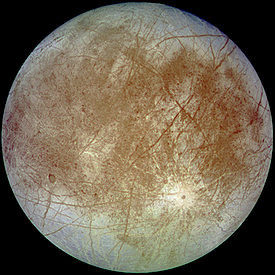
Interview:
Richard J. Greenberg, Ph.D., Prof. of Planetary Sciences, Lunar and Planetary Lab, University of Arizona, Tucson, Arizona: “The surface of Europa is very dynamic. There are very few craters. We have a good idea about how quickly craters should form as small bodies collide with the surface. Based on that rate, we know that the Europa surface has to be very, very young because there are so few craters. The surface of Europa is less than 50 million years old!
That’s only about 1% of the age of our solar system. Another way to look at that is that dinosaurs were already extinct on Earth by the time the current surface of Europa was formed. So, on Europa, you have this icy crust on top of this huge ocean – and it’s a global ocean covering the whole moon – and the icy crust is continually being re-worked so that no part of it is older than about 1% of the age of the solar system.
AND IT’S TRUE THERE IS TWICE AS MUCH LIQUID WATER ON EUROPA UNDER THAT ICE THAN THERE IS IN ALL OF THE COMBINED OCEANS OF THE EARTH?
That’s right. The H2O on Europa is about 62 miles deep and there’s a few miles of ice on top of it. But almost all of that 62 miles is liquid water. The Earth’s oceans are only a few miles deep (Marianas Trench in the Pacific Ocean at its deepest is only 6.8 miles deep). So, even though the Earth is a lot bigger, Europa has a lot more liquid water because its oceans are just so deep.
DID THAT SURPRISE YOU?
Well, I think it was a surprise back in 1979 (Voyager 2 spacecraft) when we realized there could be so much heating (from gravitational tides) out there so far from the sun. Once we overcame that surprise, then it was kind of a natural step to expect there would be an ocean there.
WHEN DID YOU ALL KNOW THAT THERE WAS TWICE AS MUCH WATER UNDER THE ICE OF EUROPA THAN ALL OF THE COMBINED OCEANS ON EARTH?
Well, we knew that there was twice as much H2O altogether around the time of the Voyager spacecraft because from the gravitational field of Europa, we could tell that the outer 100 miles was not rock. It was low density similar to H2O. We didn’t know for sure if it was melted. But once we got images from the Galileo spacecraft during the 1990s, it was really pretty clear from the resurfacing, the rapid changes in the surface that there had to be liquid water down below.
AND A LOT OF IT!
That’s right. Once we realized it was liquid, we knew that most of that 100-miles-thick had to be liquid.
WHERE THERE IS WATER, AT LEAST FROM AN EARTH POINT OF VIEW, THERE IS ALMOST ALWAYS LIFE.
That’s right. And as soon as people started thinking about the possibility of an ocean there, life was on almost everybody’s mind simultaneously! (laughs) There has been a lot of speculation and there are a couple of issues about that.
Is There Enough Oxygen
in Europa Ocean for Life?
One issue is the question of whether there would be a source of oxygen. Organisms live in our oceans because there is oxygen mixed into the water. That oxygen comes from the atmosphere. So, the question is where would you get oxygen – how could you have oxygen in the oceans of Europa, given that the ocean is under a thick layer of ice? And there is no atmosphere above the ice.
Everybody was so excited about the possibility of life that they thought about alternative forms of life – forms of life that instead of being based on oxygen the way our metabolisms are, instead they drew their energy from the chemistry of hot springs at the bottom of the ocean. There are organisms like that on Earth. But we really don’t know what it’s like on the bottom of the ocean on Europa.
What we do know about Europa is that there is some oxygen mixed in at the top of the ice. That oxygen is produced by energetic charged particles – things like electrons that are bombarding the surface. Those energetic particles are dangerous for life at the surface, but what they do is break up the H2O ice. And the O in H2O is oxygen. So, some of the ice on the surface of Europa has oxygen mixed in with it. The calculations that I’ve done recently suggest that a lot of that oxygen can work its way down (through the ice) to the ocean. This really opens up the possibility of life down there.
[ Editor’s Note: Wikipedia – “Unlike the oxygen in Earth’s atmosphere, Europa’s is not of biological origin. The surface-bounded atmosphere forms through radiolysis, the dissociation of molecules through radiation. Solar ultraviolet radiation and charged particles (ions and electrons) from the Jovian magnetospheric environment collide with Europa’s icy surface, splitting water into oxygen and hydrogen constituents. Because the surface ice might interact with the subsurface ocean, it is hypothesized that the molecular oxygen makes its way into the ocean where it could be used by biological organisms.”]
WHAT WOULD THE TEMPERATURE BE IN THE WATER?
The same temperatures that seals are quite comfortable swimming in the Earth’s Arctic regions – basically the melting point of water, 32 degrees Fahrenheit.
IS IT POSSIBLE THERE COULD BE LARGE ANIMALS IN THAT WATER ON EUROPA?
Probably wouldn’t be a great place for seals because remember, seals have to stick their heads up through the ice and breathe air. So, in that sense, Europa would be quite different. You would definitely need organisms that can exploit the oxygen in the ocean water or other chemicals that are down in the water. And temperature isn’t the problem. The question would be: is there enough food? Do you have organic compounds that life could use? Do you really have enough oxygen? It looks as though there really is quite a bit of oxygen and so it is conceivable that there could be multi-cellular organisms as well as single cellular microorganisms.
Of course, we don’t know whether there is anything living there. We don’t have any evidence, but the fact that oxygen could find its way down into the Europa ocean in abundance really increases the likelihood that there is life there.
YOU HAVE ESTIMATED THAT THERE MIGHT BE 100 TIMES MORE OXYGEN THAN SCIENTISTS HAD ANTICIPATED BEFORE NOW?
What I’ve done is consider the processes that we know reshape the surface of the ice and taking those processes into account, how quickly does the oxygen work its way down to the ocean. So, I was really surprised at how much oxygen can get down there!
HAVE YOU TALKED WITH MARINE SCIENTISTS ABOUT WHAT POSSIBLE RANGE OF LIFE MIGHT BE ON EUROPA IN THAT WATER?
Yes, I’ve talked with some quite knowledgeable marine scientists who know about life in the Arctic. Nobody knows what could be there. Almost certainly it would be quite different from anything on Earth. I want to emphasize that we just do not have any evidence yet for life there. All we have is an understanding that the conditions, as far as we know, could be hospitable to life.
Cracked Ice Surface Over Huge Ocean –
Could There Be Life?

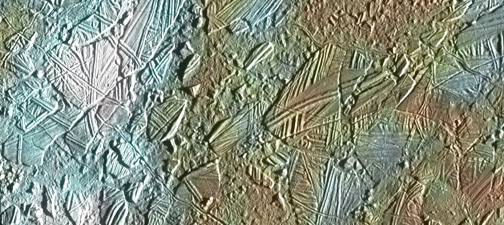
IS THERE ANY KIND OF A SCIENTIFIC INSTRUMENT THAT WE COULD PUT ON AN ORBITING SPACECRAFT THAT COULD CONFIRM ONCE AND FOR ALL IF THERE IS SOMETHING EMANATING FROM EUROPA THAT WOULD SAY THIS IS A LIFE, LIVING SIGNATURE?
I think it would be very hard to do from orbit. But one of the important things I think is the permeability of the icy crust of Europa. So just as oxygen created on the surface can find its way down to the ocean, I think a lot of material that’s on the surface now has actually worked its way up from the ocean. So, my feeling is if we could get some kind of a lander to plop down on the surface and could sample the surface, almost any place we landed on Europa – my guess is that we would be sampling material that had been part of the liquid ocean some time in the not too distant past. Even if we can’t get down to the ocean, we could probably sample it right at the surface.
Jupiter – Plus Orbital Resonance with Io, Callisto
and Ganymede – Produce Europa’s Ocean Heating,
Tides and Icy Cracks
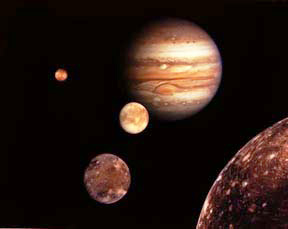
WHY IS THE EUROPA OCEAN SO DYNAMIC THAT IT KEEPS BRINGING EVERYTHING FROM BELOW UP?
The key to everything is tides. On the Earth, when we think about tides, we think about standing at the shore and the water rises and falls in two cycles a day. But really when you step back and think about what’s happening to a planet, our planet or any planet when tides are acting, is that the entire planet is being stretched and unstretched. So, when that happens on Earth, it’s the water that kind of gets pulled out and that’s why the height of the ocean goes up and down.
In a place like Europa, the whole body is also being stretched and unstretched and it happens over the course of 3.5 days – basically in every orbit of Europa around Jupiter. And it’s that continual working that is responsible for everything. The whole moon is stretched and unstretched every 3.5 days and so there is a lot of friction. And that friction is why so much of the water is melted to liquid form. But the continuous stretching and unstretching also cracks the surface and works the surface a lot.
It’s sort of like if you tried to take a raw egg and tried to change how long it is every 3.5 days, stretch it and unstretch it. Well, you can imagine what’s going to happen to the shell. The shell is going to crack and continually be worked. And that’s the same thing happening on Europa.
The whole shape of the moon is being stretched and unstretched and the ice is being cracked and worked continuously and that’s what makes the place so active.
YOU MEAN THAT ALL OF THAT STRETCHING AND CRACKING IS BEING CAUSED BY THE MASSIVE GRAVITATIONAL PULL OF JUPITER, CORRECT?
That’s right, the pull of Jupiter, and the pull of Jupiter changes at Europa because Europa is on an eccentric orbit. It’s closer to Jupiter on one part of its orbit and farther on the other. So, every time Europa goes around Jupiter, the whole shape of Europa gets stretched longer and then shorter.
Orbital Resonance
But there is something that’s even more amazing. If you think about those tides, the same tides that make all that heat and work the crust – those tides would also tend to cause Europa’s orbit to become circular, actually quite quickly. If Europa’s orbit became circular, then you wouldn’t have the tidal change. Europa would be going around, but nothing would be working the surface. It would be a constant tidal stretch and it would not change.
But there is a really interesting relationship with two of the other Jupiter moons. There are three satellites that are in what we call ‘orbital resonance.’ These satellites are Io, Europa, and Ganymede.
Every time Ganymede goes around once, Europa goes around exactly twice. And every time Europa goes around Jupiter, Io goes around exactly twice. So the ratio of their orbital periods is 1 to 2 to 4. Io’s period is exactly half of Europa’s and Ganymede’s is exactly twice Europa’s. As a result, the gravitational pull of these satellites on one another is what causes their eccentricities. It causes their orbits to be eccentric. And it is that orbital eccentricity that’s responsible for the tidal heating and tidal cracking and all the activity on the surface. So, if there were life on Europa, it would be impossible if it weren’t for this orbital resonance among the three satellite moons.
THAT WOULD ALSO EXPLAIN WHY IO HAS SO MUCH VOLCANIC ACTIVITY?
Exactly. Yes, same thing.
WHAT DYNAMIC IS ON GANYMEDE?
Well, Ganymede is further away from Jupiter. Io is the closest, so it’s been the most susceptible to tidal effects. That’s why Io has been heated to such an extreme (persistent volcanism). Europa is further out and the tidal effects there have been enough to keep most of the H2O in liquid form.
Ganymede is even further out and it has signs of some geological activity, but also a lot of it just looks old and cratered. So, it’s sort of in between. It doesn’t have anything as dramatic as what has happened on Io and Europa.
WHY DO YOU THINK THAT EUROPA HAS ENDED UP WITH THE MOST WATER IN THE SOLAR SYSTEM RIGHT NEXT TO TWO OTHER MOONS THAT DON’T HAVE WATER?
Ganymede has a lot of water. It’s just that it’s ice. The thing about Europa is that it has a lot of water and is heated by tides, so it’s liquid water.
WHY IS IT THAT EUROPA HAS SO MUCH WATER, MUCH MORE WATER THAN THE EARTH EVEN?
As you go out further in the solar system, bodies tend to have a much greater component of water. It’s one of the things that condensed out as the cloud of dust and gas around the sun was cooling. It was harder for water to condense closer into the sun where it was hot. But it could condense further out and became part of the bodies in the outer solar system. Similarly, in that mini-solar system of moons that formed around Jupiter, you have a variation in the composition of the things that were able to condense out and a lot of water was able to condense out at the distance from Jupiter where Europa is.
THEN AN ALMOST BIGGER SURPRISE IN OUR SOLAR SYSTEM IS THAT THE 3RD PLANET FROM THE SUN SHOULD HAVE SO MUCH WATER?
Actually, it’s still not entirely clear where the water came from on Earth. That’s certainly a topic of considerable interest. Scientists are modeling the process of formation of planets to try to understand how the budget of different materials found its way to different parts of the solar system.
Other Life Beyond Earth –
Will We Find On Europa First? Or On Mars?
WHEN YOU AND OTHER PLANETARY SCIENTISTS GET TOGETHER, DO YOU MAKE BETS WITH EACH OTHER ABOUT WHICH PLANET OR MOON WE WILL FIND FOR SURE LIFE ON FIRST?
I’m sure people have made that bet! (laughs)
WHAT WOULD YOU BET?
What would I bet? You know, I think there is a good chance we will find signs of past life, if not present life, on Mars. But I think there is probably an even better chance – it might be easier to find it on Europa. Probably the best chance of finding current life in our solar system right now would be on Europa. And I think people have over-estimated how hard it would be to find life on Europa. I think there has somehow been an obsession with drilling down to the ocean to find life. In other words, getting down through the icy crust. But my feeling is that because the ice is permeable, we really can sample that ocean near the surface.
BY PUTTING SOME KIND OF LANDER RIGHT ON TOP OF THAT ICE.
Right. I think if you landed on top of the ice you could sample the ocean right there.
IF YOU WERE MAKING AN EDUCATED GUESS ABOUT WHEN WE MIGHT HAVE 3-INCH-HIGH HEADLINES AROUND THE WORLD, ‘LIFE DISCOVERED BEYOND EARTH!’ – WHEN DO YOU THINK THAT MIGHT BE?
I think it’s going to be further into the future than I’d like. NASA is planning a flagship mission to the outer solar system, which will most likely be a Europa orbiter. That spacecraft will be in orbit around Europa something like 19 to 20 years from now. It will make interesting measurements and observations, but it’s not going to drop anything onto the surface of Europa. So, I don’t think there is a chance of finding life then. I really think it’s going to be when someone comes up with an affordable way to plop an instrument down on the surface of Europa that we’re really going to find out.
My feeling is that probably if there was the will and the money, it could be done within a couple of decades. But more likely, it’s going to be a few more decades after that, I’m afraid.
AND BEFORE THEN, THE MOST LIKELY OTHER PLACE IS MARS – EITHER ANCIENT DEAD LIFE OR POSSIBLY MICROBES NOW?
Yeah, we’re all over Mars and so I wouldn’t be surprised any day! (laughs) to hear there is some evidence there.”
To test speculation that Europa’s huge ocean holds life, the joint ESA and NASA Europa Jupiter System Mission is considering whether the surface ice is thin enough that a future mission could drop hydrobots to burrow into the ocean and search for life.
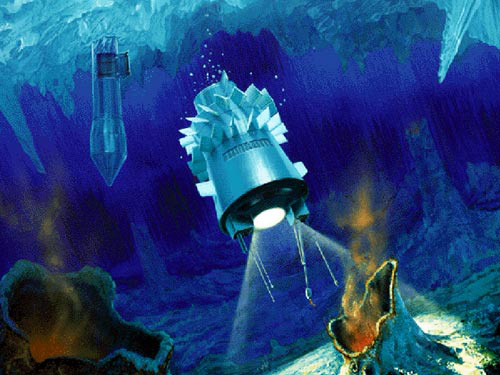
More Information:

Unmasking Europa: The Search for Life On Jupiter’s Ocean Moon
© 2008 by Richard Greenberg, Ph.D., Planetary Scientist,
Univ. of Arizona. Click here to Amazon.com.
For further information about our solar system, please see Earthfiles Archive (partial list below):
- 01/29/2009 —Part 2: Nanodiamonds Link Outer Space Impactors to Earth Extinctions 12,900 Years Ago
- 01/29/2009 —Part1: Nanodiamonds Link Outer Space Impactors to Earth Extinctions 12,900 Years Ago
- 07/16/2008 —Astronomical Data in July 2008 U. K. Crop Formations?
- 03/28/2008 —Earth-Size Planet Beyond Pluto and Kuiper Belt?
- 10/11/2007 —Carancas, Peru Meteorite Could Be 10 Tons
- 07/12/2007 —First Water Confirmed in Extrasolar Planet’s Atmosphere
- 03/30/2007 —Fastest Orbiting Object in Our Solar System is One of Strangest
- 01/13/2007 —Confusing Sun: Will Solar Cycle 24 Be Most Intense On Record?
- 12/01/2006 —Deep Impact and Stardust: Are Comets Made of the Same Stuff?
- 05/19/2006 —Simple “Binocular” Telescope Finds Another Planet Beyond Solar System
- 11/18/2005 —Is the Sun Heating Up?
- 09/16/2005 —”Planet X” and the Kuiper Belt’s Oddballs, “Santa” and “Easterbunny”
- 08/12/2005 —Deep Impact Spectra: Carbonate, PAHs and Some Amino Precursors in Comet Tempel I
- 03/25/2005 —Glow of Distant Worlds Seen For First Time
- 02/17/2005 —Iapetus and Enceladus: Baffling Moons of Saturn
- 01/22/2005 —Titan – A Moon Where It Rains Methane Into Seas and Soils of Hydrocarbons
- 08/28/2004 —Near-Earth Asteroid 4179 Toutatis Comes By Again On September 29, 2004
- 06/25/2004 —Wild 2, An Amazing Comet
- 06/18/2004 —German Scientist Werner von Braun Anticipated Terrorists, Asteroids and ETs on American “Enemy’s List”
- 06/11/2004 —Cassini Spacecraft Will Rendezvous with Saturn July 1, 2004
- 02/03/2004 —Planet 150 Light Years from Earth Has Oxygen and Carbon Atmosphere
- 02/27/2003 —Pioneer 10 Goes Silent
- 10/07/2002 —Large Kuiper Belt Planetoid Found Beyond Pluto
- 09/07/2002 —Does Gravity Travel the Same Speed as Light?
- 07/11/2002 —Hubble Telescope Photographs Seven Objects Traveling In Pairs Beyond Pluto
- 06/14/2002 —Another Solar System Like Ours?
- 02/24/2002 —Mysterious Slowing of Pioneer Spacecraft 7 Billion Miles from Earth
- 01/26/2002 —Something Is Perturbing Comet Orbits in the Oort Cloud Surrounding Our Solar System
- 03/18/2001 —Can Earth Plants and Bacteria Grow On Mars?
- 02/25/2001 —A New Martian Mystery
- 01/14/2001 —An Australian Zircon Crystal is 4.4 Billion Years Old
- 10/09/2000 —Astronomy Updates
- 10/01/2000 —A Search for Earth’s First Life
- 03/11/2000 —Is 433 Eros Asteroid Younger Than Expected?
- 02/16/2000 —433 Eros, Orbiting An Asteroid Up Close
- 12/01/1999 —Six More Planets Discovered 60 to 190 Light Years Away
- 11/18/1999 —Short Environmental Updates
- 10/25/1999 —A Mysterious “Perturber” at the Edges of Our Solar System
- 08/28/1999 —Oddball Quasar and Salt Water Inside Meteorite
- 06/15/1999 —Current Brightest Binocular Comet and Upcoming Solar Eclipse
- 03/14/1999 —Africa Stone Circle and Triangle of Lights over Tucson, Arizona
Websites:
NASA and ESA Europa Jupiter System Mission: http://opfm.jpl.nasa.gov/europajupitersystemmissionejsm/
NASA/JPL Ocean Surface Topography: http://sealevel2.jpl.nasa.gov/jr_oceanographer/oceanographer-carsey.html
NASA/JPL Ice Explorer for Other Worlds: http://www.jpl.nasa.gov/releases/2002/release_2002_6.html
NASA/JPL Comparison of Jupiter’s Galilean Moons:
http://photojournal.jpl.nasa.gov/catalog/PIA00743
Solar System, Europa: http://www.solarviews.com/eng/europa.htm
Solar System, Ganymede: http://www.solarviews.com/eng/ganymede.htm
Solar System, Io: http://www.solarviews.com/eng/io.htm
Solar System, Callisto: http://www.solarviews.com/eng/callisto.htm
NASA Jupiter: http://www.nasa.gov/worldbook/jupiter_worldbook.html
© 1998 – 2023 by Linda Moulton Howe.
All Rights Reserved.







